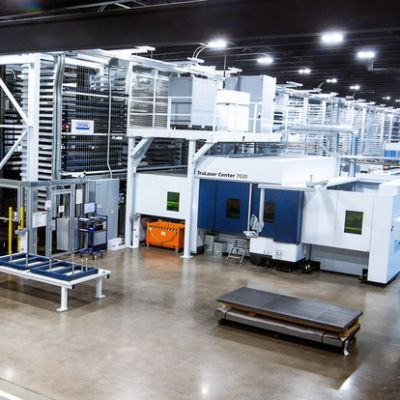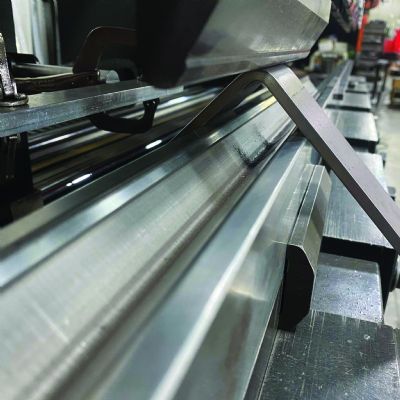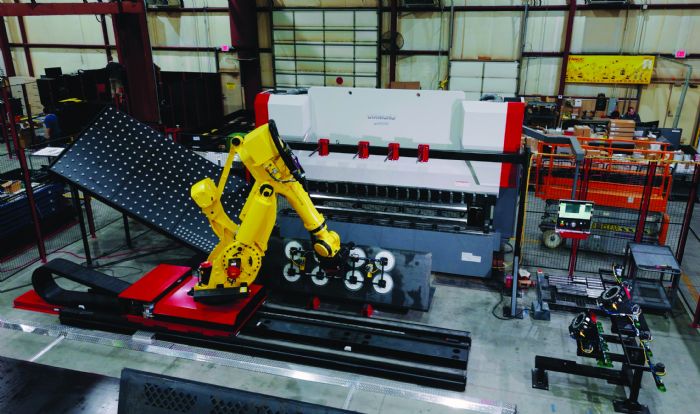 Interest in laser cutting sparked another Jenkins Iron & Steel interest in automation.
Interest in laser cutting sparked another Jenkins Iron & Steel interest in automation.
“Our first laser cutting machine did not cut faster than plasma cutting for us, but we were sold on its automation capabilities,” Jenkins explains. “Adding automation allows for cutting overnight, unattended. We work one 10-hr. shift, so we wanted to find a way to utilize the machine during the remaining 14 hr. in the day. Shortly after installing the machine in 2017, we added load/unload automation to cut during the remaining hours.”
The company was hooked. Within 2 yr., it added an 8-kW Mitsubishi fiber laser cutting machine with load/unload automation, and then a third—this one a 10-kW machine. It was here that Jenkins Iron & Steel opted also for a Mitsubishi material-storage tower to keep the hungry trio fed and meet increased part-volume demands. Today, the company boasts three Mitsubishi high-power fiber laser cutting machines from MC Machinery Systems—two 10-kW machines and a 12-kW, all with load/unload automation and linked to a material-storage tower.
Automated Press Brake to Keep Up
With its stable of fiber laser cutting machines, Jenkins Iron & Steel has been able to keep up with cutting demand, but this brought another challenge—dealing with all of those cut parts downstream. For attachment assembly, the company makes good use of 14 robotic-welding machines following tack welding via manual operations. However, a prior step, bending those cut parts via three manually operated press brakes, required attention.
“We’ve always wanted to incorporate a robotic press brake, not only to address part volumes, but because press brake bending is a demanding job,” explains Jenkins. “Finding someone willing to lift big, heavy parts and maneuver sheet metal inside of a press brake is difficult.”
The problem, he says, was tying a robot and press brake together to produce parts accurately and in volume.
“It’s one thing to buy and program a robot and press brake individually,” Jenkins offers, “but quite another to make them communicate and seamlessly work together to produce high-quality parts every time. We struggled in locating a company to do that.”
Ultimately, in 2024 the company selected Acieta, an automation and robotics integrator, and worked with its Council Bluffs, IA, location.
“We’ve wanted to automate a press brake for as long as we can remember, and it took us this long to find an outfit to integrate the technology successfully,” says Jenkins. “Acieta had the knowledge to make it all work. We had heard horror stories where integration of robots and press brakes didn’t go well.”
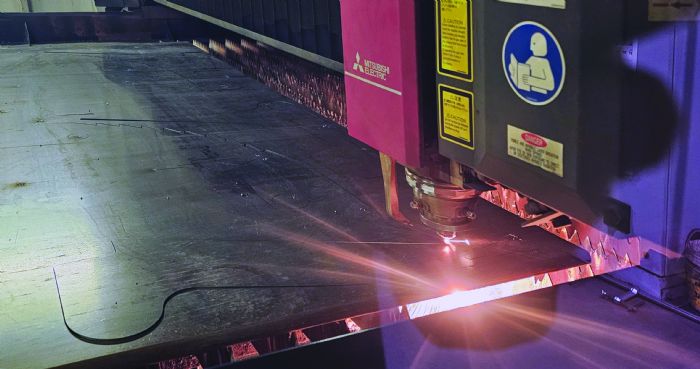 Acieta tied together a solution consisting of a Mitsubishi BH25040 hydraulic/electric press brake and Fanuc M900iB/700 industrial robot. The hybrid CNC press brake boasts a 250-ton capacity with a 146-in. bend length and 10-in. stroke height. Its Diamond BH dual-drive system controls high-speed—200 mm/sec. —up-and-down movement with a ball screw, and bending movement via a servohydraulic piston. The six-axis Fanuc robot (Acieta is a Fanuc-authorized service integrator), mounted on a robot transfer unit, provides repeatability of 0.1 mm, and payload capacity of 700 kg with a 2832-mm max. reach, plenty to handle parts that, in this application, may weigh as much as 85 lb. and measure to 6 by 10 ft.
Acieta tied together a solution consisting of a Mitsubishi BH25040 hydraulic/electric press brake and Fanuc M900iB/700 industrial robot. The hybrid CNC press brake boasts a 250-ton capacity with a 146-in. bend length and 10-in. stroke height. Its Diamond BH dual-drive system controls high-speed—200 mm/sec. —up-and-down movement with a ball screw, and bending movement via a servohydraulic piston. The six-axis Fanuc robot (Acieta is a Fanuc-authorized service integrator), mounted on a robot transfer unit, provides repeatability of 0.1 mm, and payload capacity of 700 kg with a 2832-mm max. reach, plenty to handle parts that, in this application, may weigh as much as 85 lb. and measure to 6 by 10 ft.
Bye-Bye Bottleneck
Installed in early 2024, the robotic press brake has paid big dividends, according to Jenkins. Previously, press brake operators had to load, maneuver and unload 80-100 attachment parts per day, a monotonous, tiring and potentially unsafe proposition. Now, that’s a task that the robot handles effortlessly and with precision. And, the automation has eliminated the press brake bottleneck.
“The robotic press brake has made a world of difference—the operators are happy and the welding department has the parts it needs in abundance,” Jenkins says. “Receiving high-quality parts off of the laser cutting machines and then off of the robotic press brake makes everything fit together correctly, and more easily and quickly in the welding and assembly operations."
In practice, forklifts transport snow bucket parts, for example, from the laser cutting machines and stack them at the robotic press brake. The robot picks parts individually, maneuvers and loads them into the press brake, and then unloads them for transport to welding operations. After welding, operators check welds and perform finishing touches, then the assemblies are transported for inhouse shotblasting, powder coating and shipping—Jenkins Iron & Steel truly is a one-stop shop for attachment production.
To gain the most from its production technology and automation, company management has put a lot of thought into production flow and resulting plant layout.
“Fortunately, we’re located out in the country and have quite a few acres where we’ve been able to add manufacturing space, so we are not constrained,” Jenkins says, noting that the company even constructs its own buildings. “We’ve had a lot of discussion on where to place processes and equipment, and have the room to place it most efficiently.”
People Made the Technology Successful
The attention to product design, manufacturing technology, automation and efficient workflow all take place in service to Jenkins Iron & Steel’s most valuable resource: its people, according to Jenkins.
“We have a good group here that get along very well,” he says. “People here are not a number, and having nice equipment helps everyone. And, helpful automation definitely is a morale booster—people can work with something that doesn’t always break down.
“I was very vocal with our operators that we all are in this together during the process of bringing in the robotic press brake, as they were worried about having to learn all these new things about how it works and how to operate it,” he continues. “‘We’ll learn about it together and get comfortable with it,’ I said. Once we did that and the automation worked well for us, it was a big relief—the stress went away for everyone.”
The combination of experienced employees, many of them having risen through the ranks at Jenkins Iron & Steel, and a spirit of technology adoption has served the company well.
“Back in 2009, our biggest piece of machinery was an ironworker, and we thought it was the greatest,” Jenkins concludes. “Then installing our first laser cutting machine was a huge step, and adding the robotic press brake was another. We just grew into this, improving our equipment when needed and adding automation to remove bottlenecks. Our team has learned how to operate and program all of this for our constantly evolving attachment designs, and has an appreciation for how far we’ve come. It didn’t just happen overnight.” MF
View Glossary of Metalforming Terms
See also: MC Machinery Systems, FANUC America, Inc., Mitsubishi Electric US, Inc., Acieta







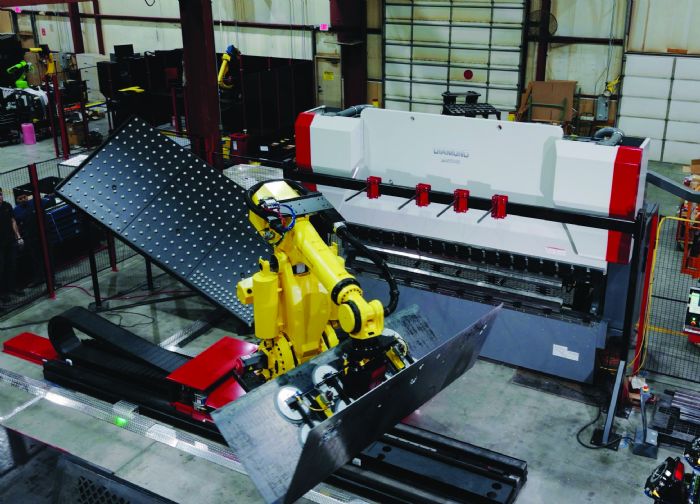 Enter Jenkins Iron & Steel. A family company that previously dealt in semi-trailer repair, buying and selling scrap steel, and other fabrication efforts, it joined the skid-steer-attachment world in 2009, initially designing and building snow and material buckets. Today, Jenkins Iron & Steel, with 85 employees and operating out of a 250,000-sq.-ft. plant in Long Prairie, MN, 125 mi. northwest of Minneapolis, fabricates more than 45 different types of attachments while continuously adding to its product roster.
Enter Jenkins Iron & Steel. A family company that previously dealt in semi-trailer repair, buying and selling scrap steel, and other fabrication efforts, it joined the skid-steer-attachment world in 2009, initially designing and building snow and material buckets. Today, Jenkins Iron & Steel, with 85 employees and operating out of a 250,000-sq.-ft. plant in Long Prairie, MN, 125 mi. northwest of Minneapolis, fabricates more than 45 different types of attachments while continuously adding to its product roster. 